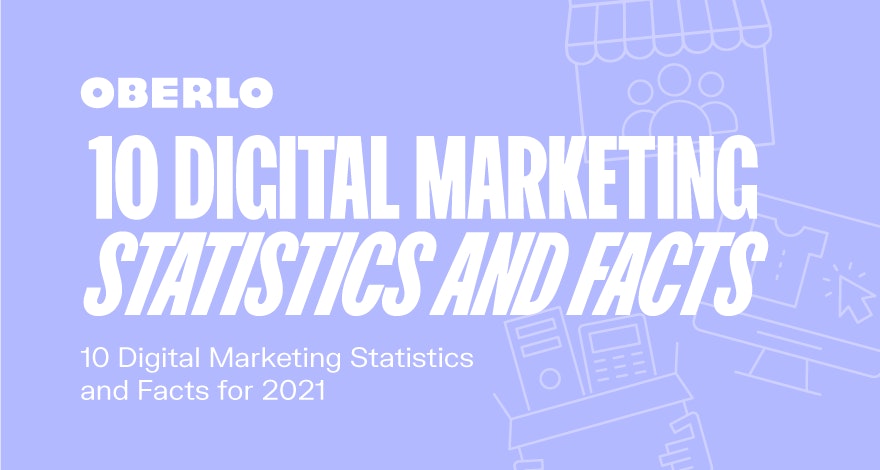With no customer fulfillment, packing, and shipping to worry about, a dropshipping business may come across as a lot more straightforward to run.
Sure, these are big things off your plate. But running a dropshipping business is certainly not easy.
By and far, one of the most important aspects to focus on when running or starting a dropshipping business is digital marketing. Without it, you’ll be hard pressed to get the visibility your store needs to generate sales and grow.
But before you jump into crafting a strategy, there are a few key digital marketing statistics you need to know about.
From advertising statistics to the top digital marketing platforms and more, here are ten digital marketing stats and facts you need to know about in 2021 to power your dropshipping store.
Let’s get to it.

Don’t wait for someone else to do it. Hire yourself and start calling the shots.
Get Started Free1. How Many Unique Mobile Users Are in the World?
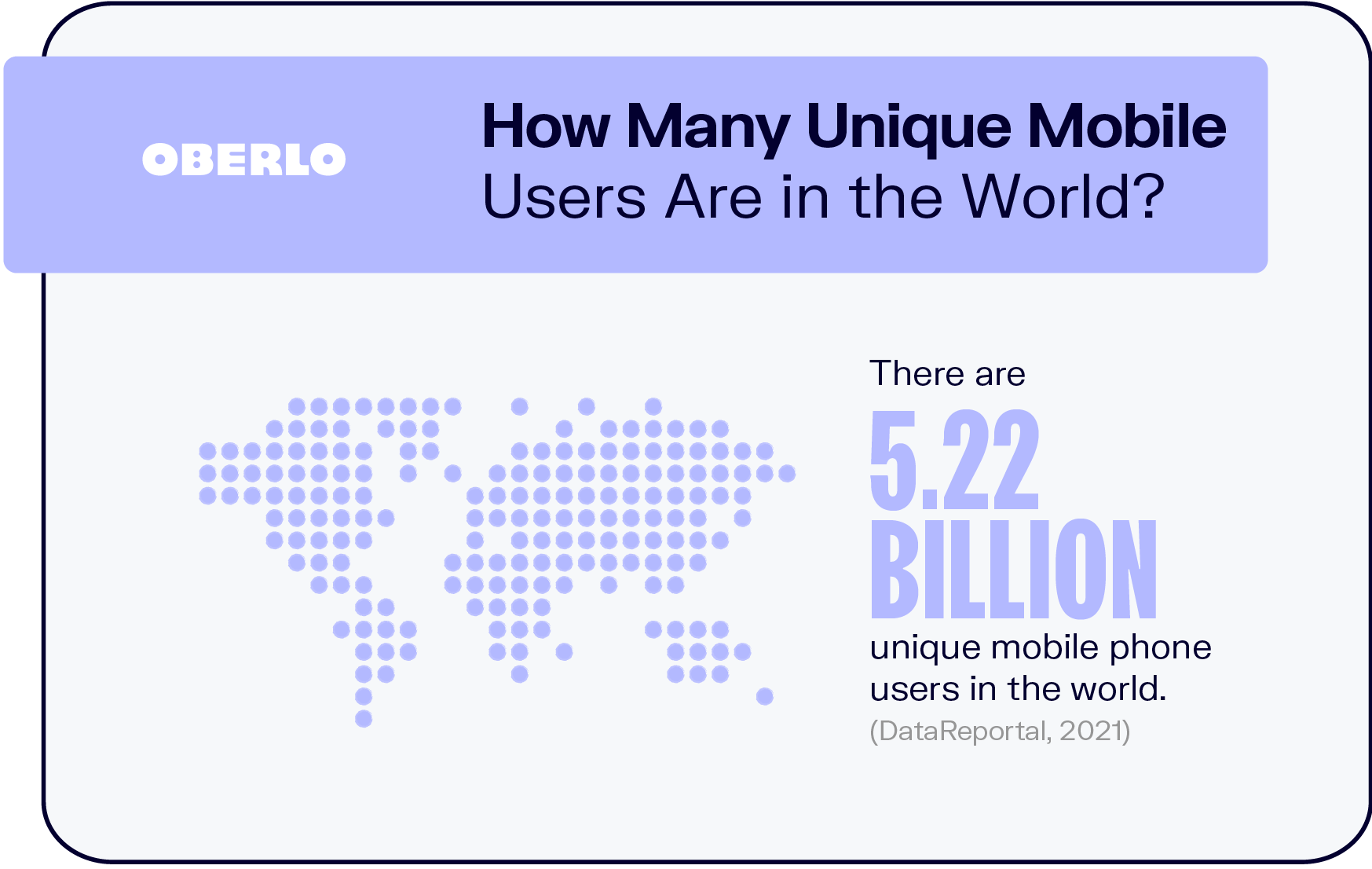
The first stat on this list of digital marketing statistics will help you understand the importance of mobile marketing.
The latest advertising statistics show that as of January 2021, there were 5.22 billion unique mobile phone users in the world (DataReportal, 2021). This makes up 66.6 percent of the total global population.
It also marks a 1.8 percent year-over-year increase from January 2020. In this one year, the world gained 93 million more mobile phone users. If these digital marketing statistics continue to trend, we’ll be seeing even more mobile phone users over the coming years.
Smartphones are the most popular type of mobile device, with 96.6 percent of all internet users owning smartphones. In comparison, just nine percent use mobile phones that are non-smartphones and 34.3 percent are tablet users.
Whether you’re already running an ecommerce store or are thinking about starting one, you definitely want to make mobile advertising part of your digital marketing plan.
2. US Digital Marketing Statistics: Mobile Ad Spend
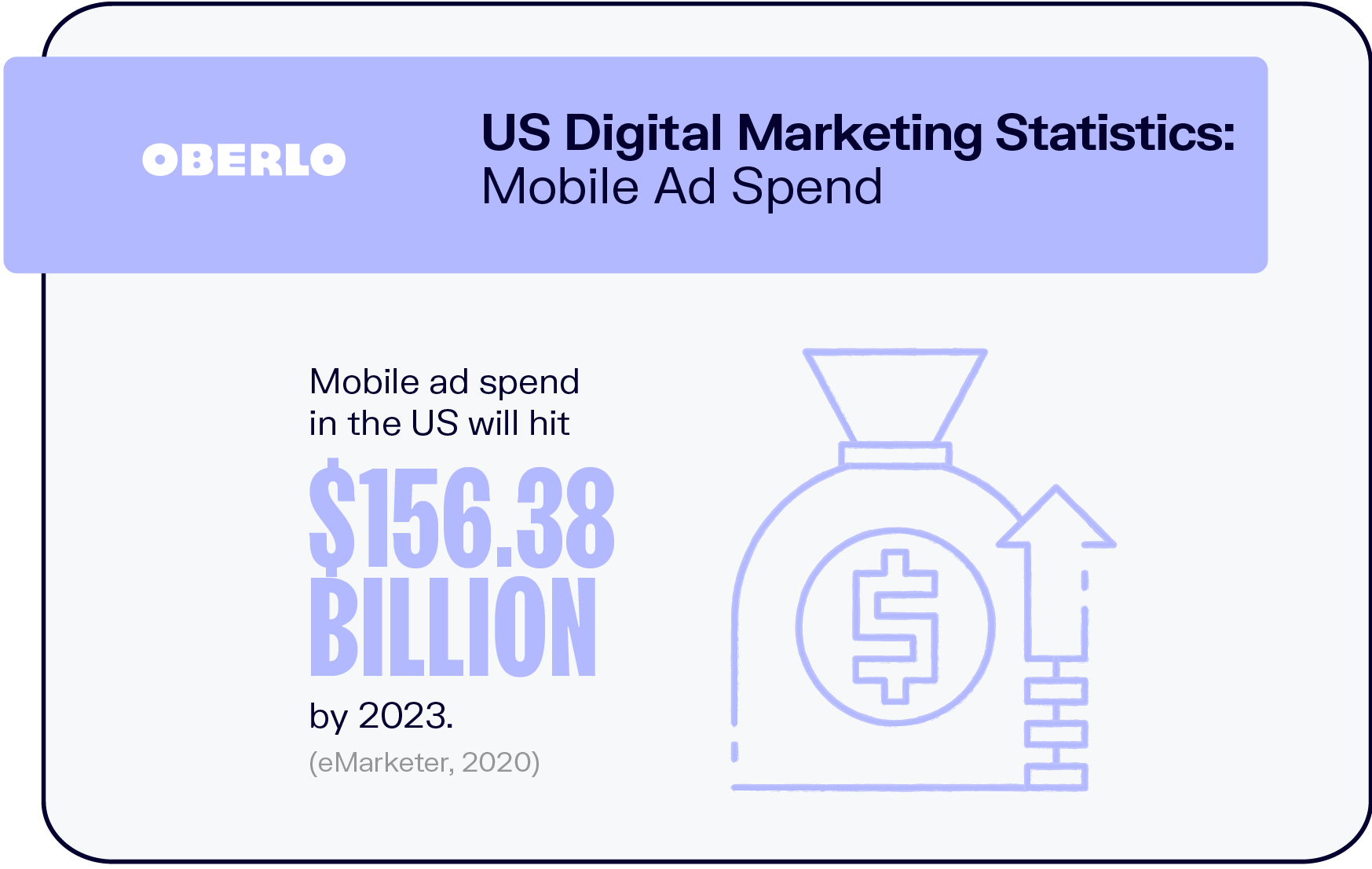
Given the growing number of mobile phone users, it should come as no surprise that mobile ad expenditure in the US has also been increasing.
Recent digital marketing statistics predict that mobile ad spend in the US will hit $156.38 billion by 2023 (eMarketer, 2020). This is actually a slight upward revision from the $155.26 billion that was previously forecast, prior to the coronavirus pandemic.
Because of the pandemic, digital marketing stats actually show a growth slowdown in mobile ad spend in 2020 as businesses wound down their overall marketing efforts. However, the increased mobile usage among consumers is expected to push those growth figures back up in the next few years.
Experts say COVID-19 has triggered mobile behavioral changes in its users. More have started to engage with video streaming, gaming, and shopping on their mobile devices. This, in turn, has prompted innovation among advertisers as they adapt to these new shifts.
3. Mobile Organic Search Engine Visits
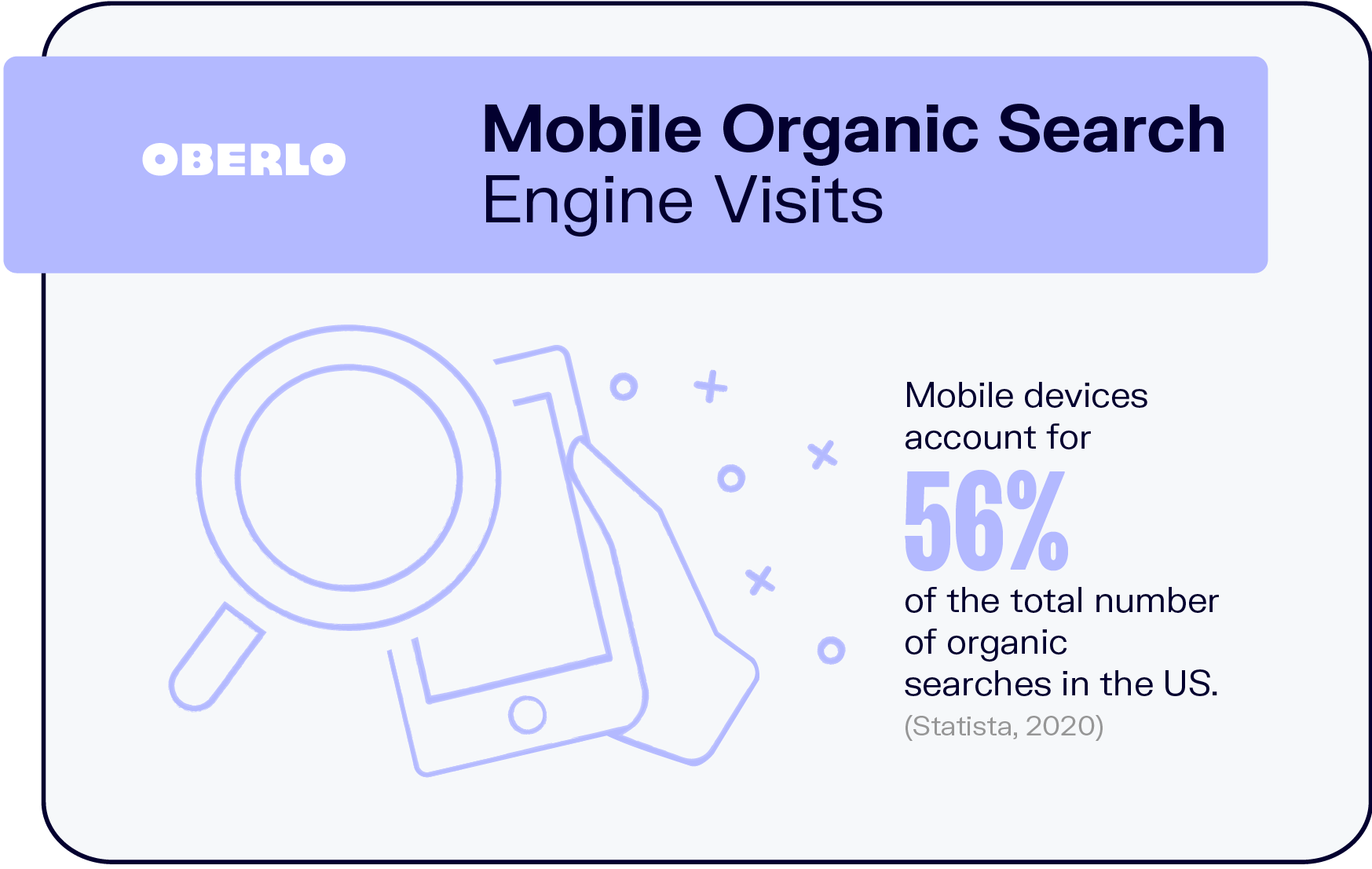
If the above digital marketing facts on mobile have got you thinking about investing in it, then make sure to allocate a portion of your budget to optimizing it for organic searches.
That’s because the mobile share of organic search engine visits has been on the rise over the past few years. As of the first quarter of 2020, mobile devices accounted for 56 percent of the overall number of organic search engine visits in the US (Statista, 2020). In comparison, just five years prior in Q1 2020, this figure was 45 percent.
This is also in line with the growing number of US mobile phone search users. In 2016, there were 177.8 million mobile phone users conducting organic searches. By 2020, that number had ballooned to 211 million.
And if you’re wondering which search engine to focus on, Google is the way to go. In December 2020, 94.48 percent of mobile searches in the US were conducted on Google.
4. Global Digital Marketing Spend in 2021
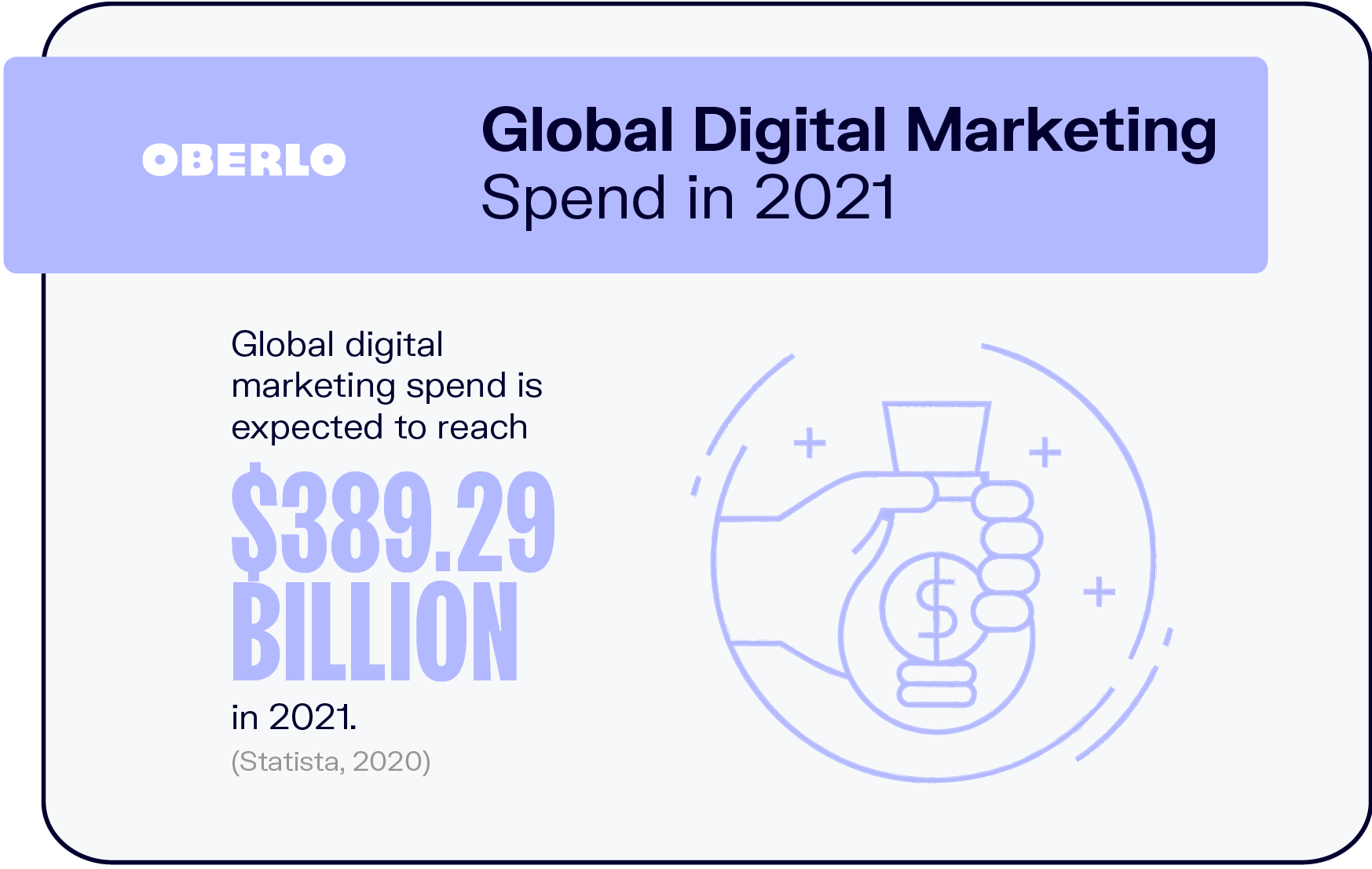
Still yet to believe in the power of online marketing? This next digital marketing stat may just change your mind.
The global digital ad spend is expected to reach $389.29 billion in 2021 (Statista, 2020). This is a 17 percent increase from 2020, during which annual growth slowed due to economic issues brought on by the coronavirus pandemic.
At $332.84 billion, 2020’s global digital marketing spend grew just 2.4 percent year over year. Nevertheless, growth is set to rebound, with consistent increases over the next few years.
It’s expected that 2022 will see another year of significant growth as digital ad spend is set to rise by 13.3 percent to $441.12 billion. By 2024, digital advertising spending worldwide is projected to exceed half a trillion to $524.17 billion. To put things into perspective, this is a whopping 85.7 percent increase from 2018.
5. What Percentage of Marketing Is Digital?
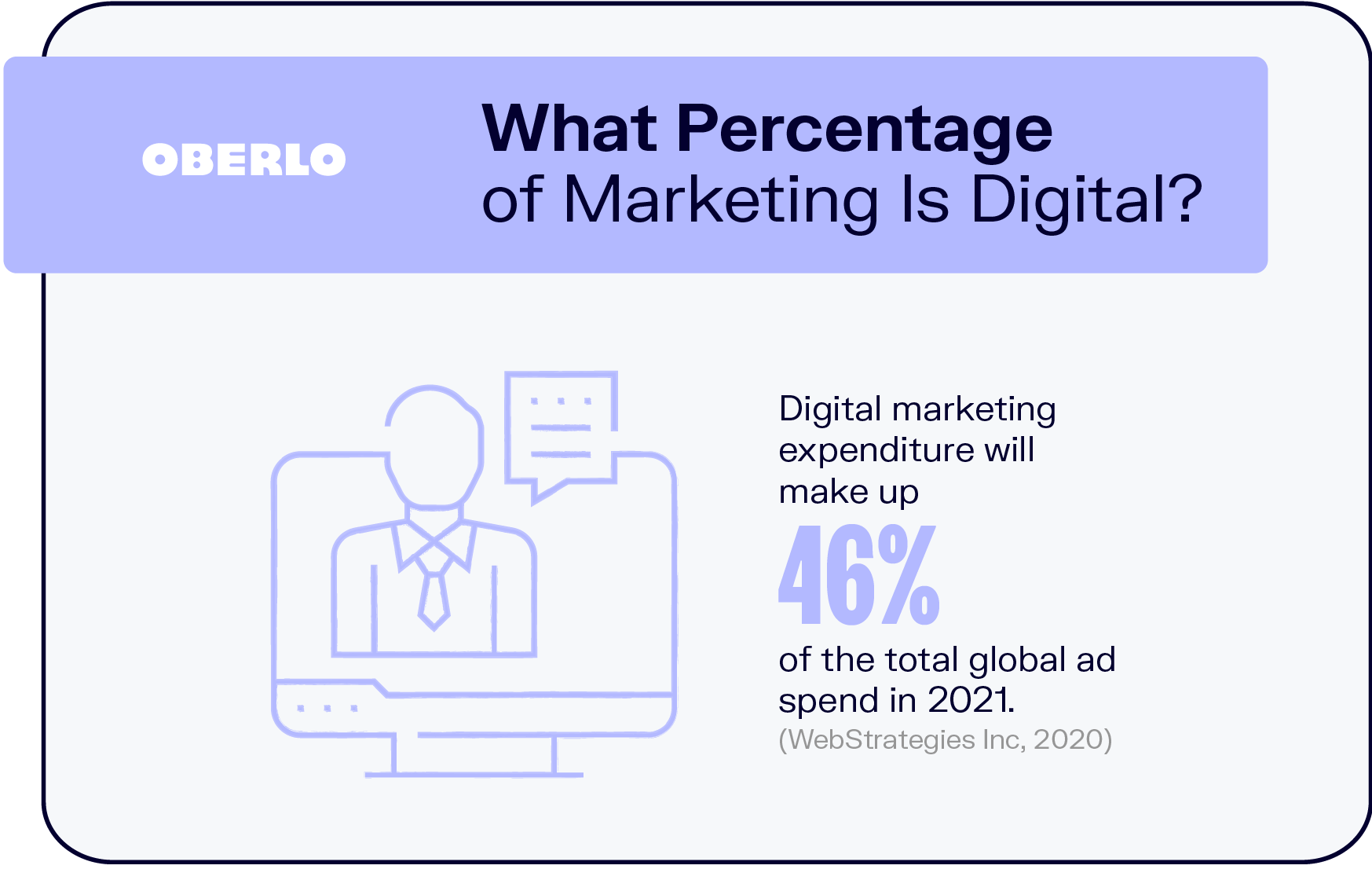
The digital marketing statistics we’ve mentioned so far should go to show just how popular online marketing is for businesses. But just how widespread is it in the grand scheme of things? After all, there is still traditional (offline) marketing to engage with.
According to the latest digital marketing statistics, expenditure on online marketing will make up 46 percent of the total global ad spend in 2021 (WebStrategies Inc, 2020). The exact proportion for each company will, naturally, vary according to factors such as sector, expansion strategy, target market, and so on.
For instance, traditional businesses, especially those targeting the older generation, who are less likely to be online, are expected to have a more balanced investment in both online and offline marketing.
On the other hand, online ecommerce businesses such as dropshipping and print-on-demand stores will probably have a much heavier financial reliance on digital marketing.
But already, digital marketing statistics show that online marketing is already proving to be increasingly more popular than traditional marketing. In fact, online ad spend is expected to more than double television ad spend in 2021.
6. Which Digital Platforms Are Marketers Upping Their Spend on This Year?
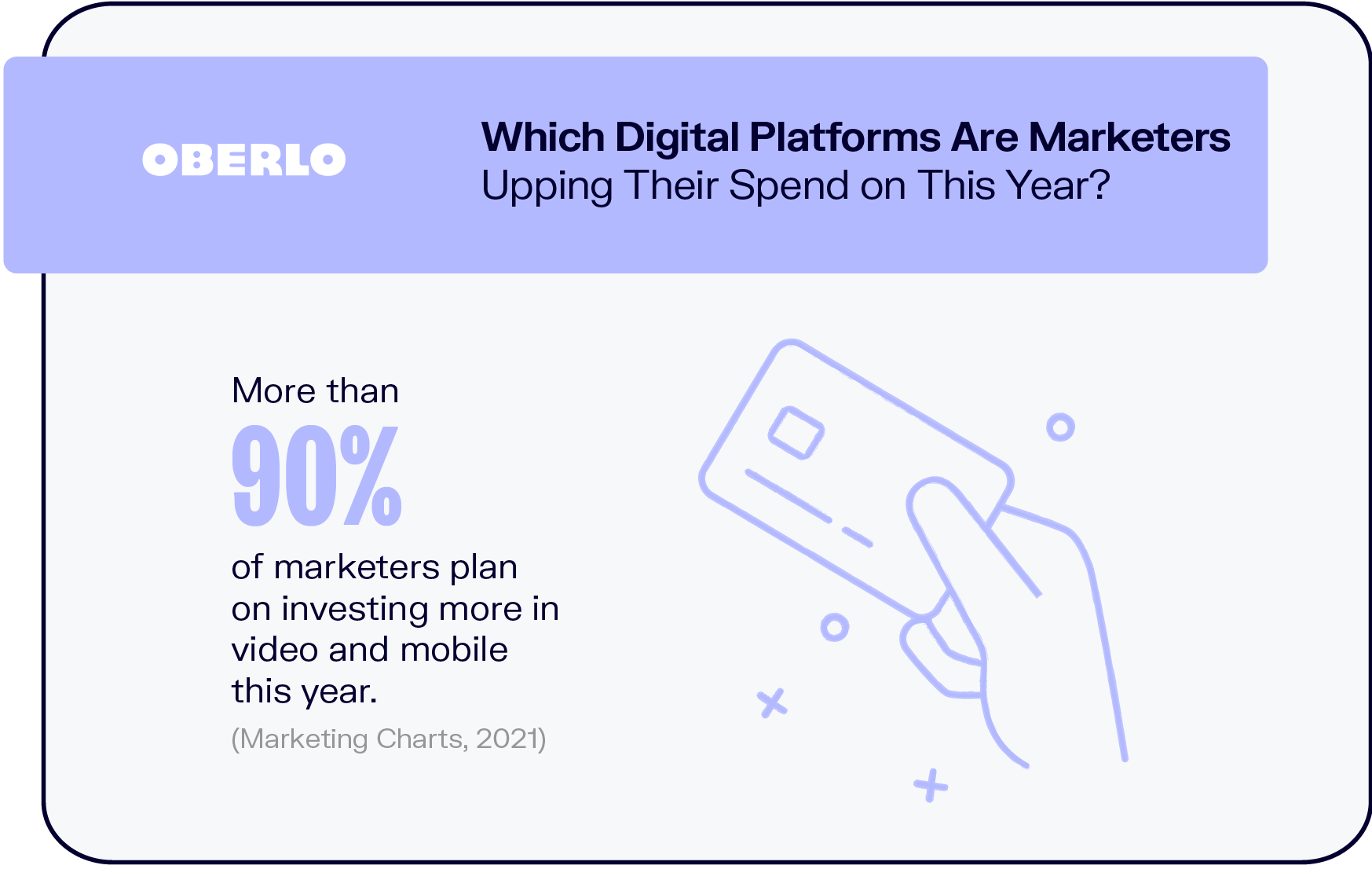
As an overarching category, there is a wide range of tools within digital marketing that businesses may have different priorities for. Just where are they investing most of their money?
New digital marketing stats in 2021 show that online video and mobile will be the most popular online marketing channels this year. More than nine in ten marketers plan on investing in these platforms and most of them will even be increasing their expenditure (Marketing Charts, 2021).
This is particularly so for online video: seven out of ten marketers say they will have a bigger budget for it, while just three percent expect to be spending less.
As a matter of fact, more than half (54 percent) expect marketing spend on YouTube, the world’s most popular video-sharing platform, to increase.
Interestingly, 64 percent of marketers are also planning on spending more on mobile in 2021. With consumers spending four out of every five digital minutes on their mobile devices, this is definitely a worthy investment.
7. Which Digital Ad Formats Will Experience Growth?
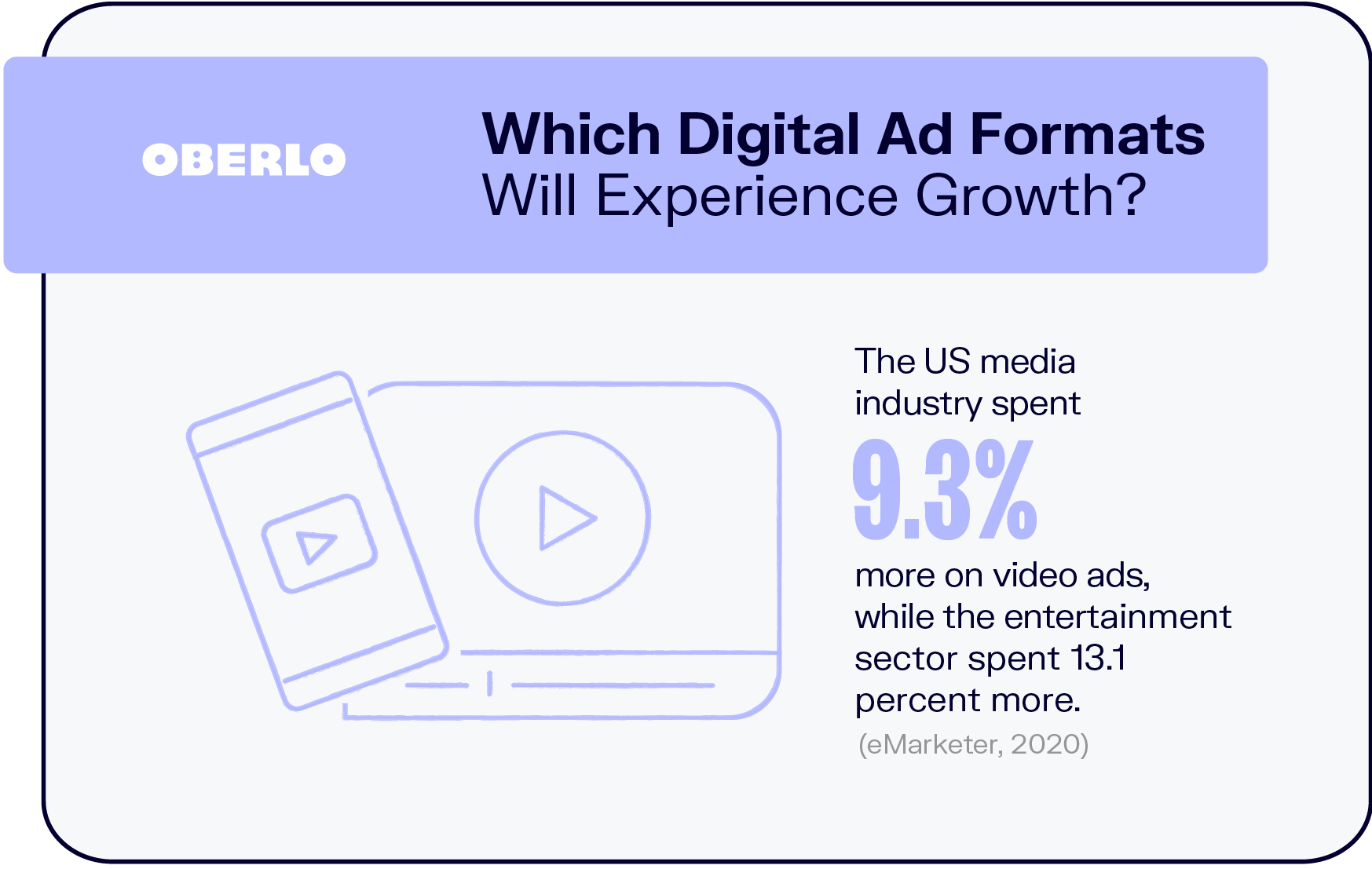
Despite businesses scaling back their online marketing budget in 2020 as a result of the coronavirus pandemic, video is expected to be the biggest survivor of all digital marketing efforts.
Not only is it a priority among marketers, as seen in the previous few digital marketing statistics, it is also the only ad format that media and entertainment industries have increased their investment in.
More specifically, companies in the media industry spent 9.3 percent more of their marketing expenditure on video ads, while the entertainment sector spent 13.1 percent more (eMarketer, 2020).
The increase in investment in these two ad formats actually came despite a general fall in digital ad spend by both industries. In 2020, the media and entertainment sectors decreased their overall online ad spend by 9.3 percent and 6.9 percent respectively.
8. Digital Marketing Spend on TikTok in 2021
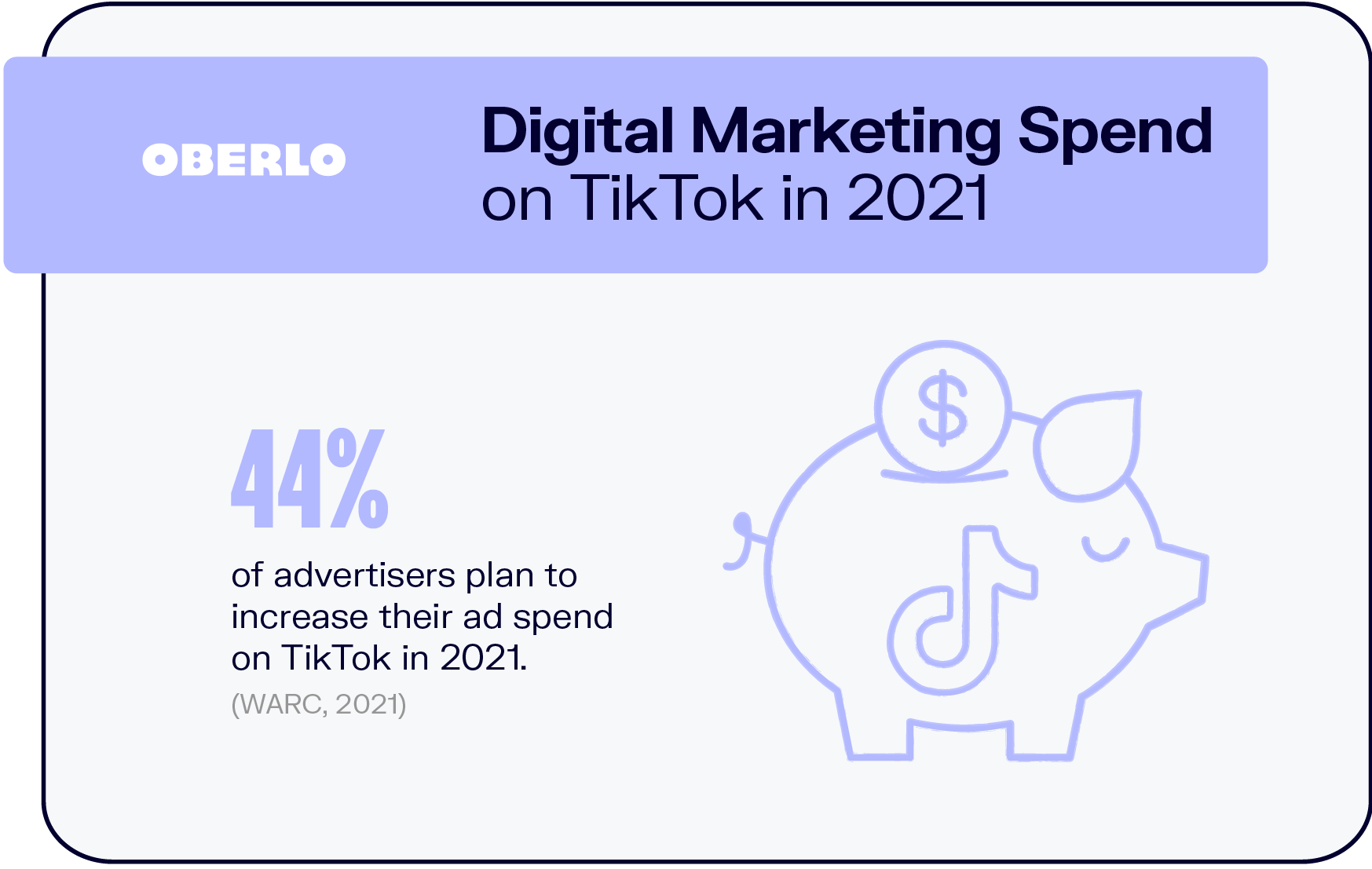
With 3.78 billion social media users worldwide, a social media marketing strategy is a must-have for all businesses. And if there’s one platform and one platform only that you should be focusing on, let that be the fastest-growing platform in recent years – TikTok.
In 2020, TikTok saw its user base grow by a whopping 75 percent in a matter of nine months. Unsurprisingly, it is also making more money than any other app.
If that’s not impressive enough, all that is about to compound even more in 2021: 44 percent of advertisers intend to increase their ad spend on TikTok this year (WARC, 2021). That’s five percentage points more than Facebook, commonly called the “King of Social Media.”
9. Revenue From Facebook Ads Revenue Continues To Grow
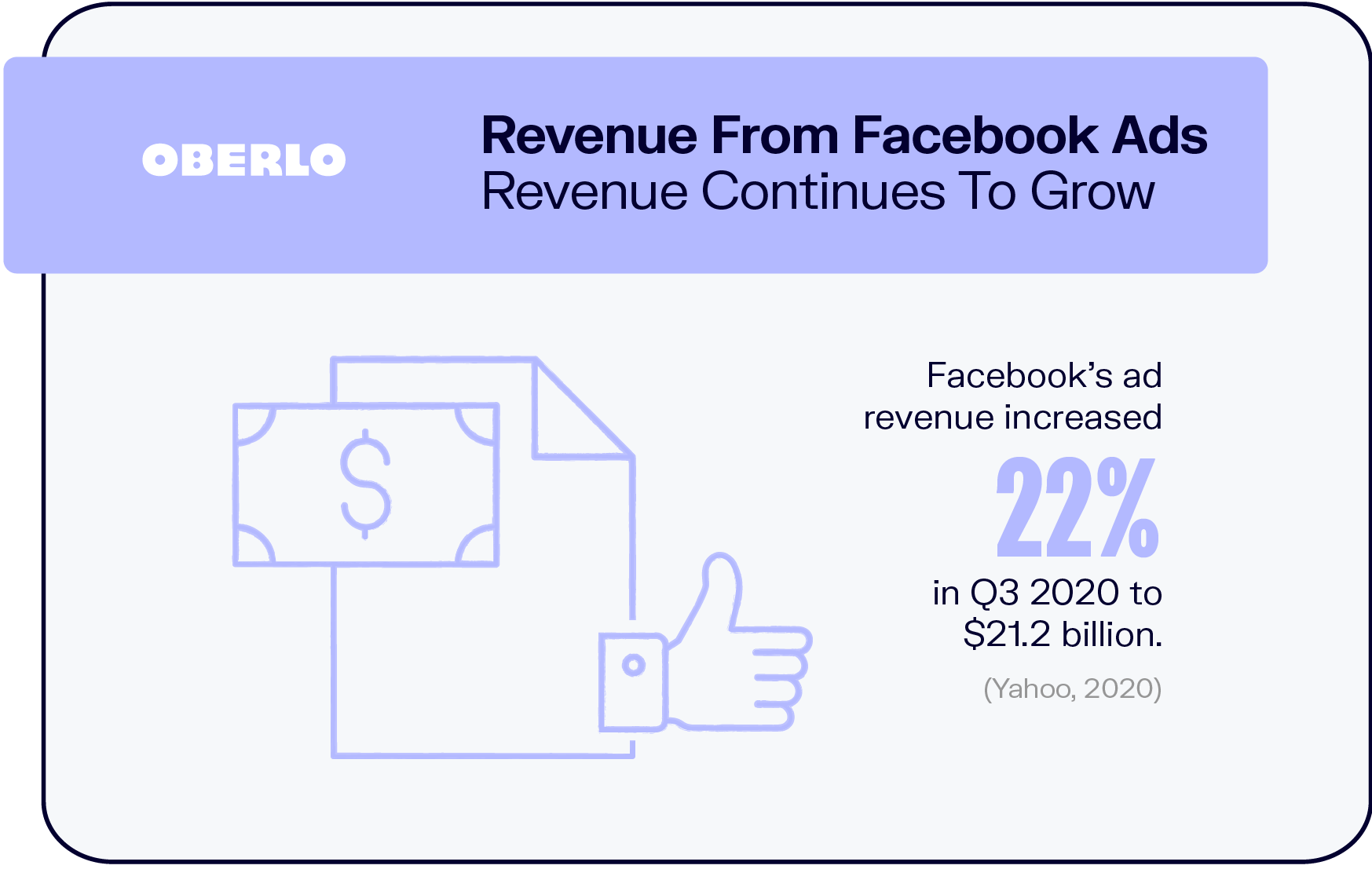
It’s nearly impossible to talk about digital marketing statistics without mentioning Facebook. With an advertising audience of 2.14 billion, it’s the default marketing platform for many ecommerce businesses.
Its growing popularity also means that the company is seeing impressive growth figures from its ad revenue. Recent Facebook advertising statistics show that the company’s revenue from advertisers increased by 22 percent in the third quarter of 2020 to $21.2 billion (Yahoo, 2020). This is 21.8 percent more than 2019’s third-quarter figures.
Revenue from ads has long made up the majority of Facebook’s total revenue. In the same quarter, the company brought in $21.5 billion in total revenue. In other words, 98.84 percent of Facebook’s revenue comes from ads on its platform.
10. Online Experiences Begin With a Search Engine

Last but not least on this list of digital marketing statistics is one on consumers’ reliance on search engines.
The latest online marketing statistics show that nearly seven out of ten (68 percent) of online experiences start with the use of a search engine (BrightEdge, 2019). This applies to both organic and paid search, with organic taking a much bigger slice of the pie (53 percent organic vs 15 percent paid).
This trumps all other types of searches, including organic social searches, which constitutes just five percent. Incidentally, the percentage of organic searches on social media has remained at this figure since 2014.
Considering increasing your digital marketing expenditure on search? Then know this: Google is the leading search engine worldwide, with more than 90 percent of the market share. So if there’s one search engine to focus on, Google’s your answer.
Conclusion
These ten key digital marketing statistics should have provided you with a better idea of where to start.
But much more research may be required from your end. From YouTube ads to social media and even influencer marketing, there’s much to explore and many more specific advertising statistics that could help you prioritize your marketing budget and efforts.
What’s your favorite digital marketing platform? Let us know in the comments below!
Summary: Digital Marketing Statistics
- There are 5.22 billion unique mobile phone users in the world. (DataReportal, 2021)
- Mobile ad spend in the US will hit $156.38 billion by 2023. (eMarketer, 2020)
- Mobile devices account for 56 percent of the total number of organic searches in the US. (Statista, 2020)
- Global digital marketing spend is expected to reach $389.29 billion in 2021. (Statista, 2020)
- Digital marketing expenditure will make up 46 percent of the total global ad spend in 2021. (WebStrategies Inc, 2020)
- More than 90 percent of marketers plan on investing more in video and mobile this year. (Marketing Charts, 2021)
- The US media industry spent 9.3 percent more on video ads, while the entertainment sector spent 13.1 percent more. (eMarketer, 2020)
- 44 percent of advertisers plan to increase their ad spend on TikTok in 2021. (WARC, 2021)
- Facebook’s ad revenue increased 22 percent in Q3 2020 to $21.2 billion. (Yahoo, 2020)
- 68 percent of online experiences start with the use of a search engine. (BrightEdge, 2019)

